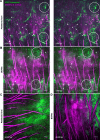A mouse ear skin model to study the dynamics of innate immune responses against Staphylococcus aureus biofilms
- PMID: 31996131
- PMCID: PMC6990489
- DOI: 10.1186/s12866-019-1635-z
A mouse ear skin model to study the dynamics of innate immune responses against Staphylococcus aureus biofilms
Abstract
Background: Staphylococcus aureus is a human pathogen that is a common cause of nosocomial infections and infections on indwelling medical devices, mainly due to its ability to shift between the planktonic and the biofilm/sessile lifestyle. Biofilm infections present a serious problem in human medicine as they often lead to bacterial persistence and thus to chronic infections. The immune responses elicited by biofilms have been described as specific and ineffective. In the few experiments performed in vivo, the importance of neutrophils and macrophages as a first line of defence against biofilm infections was clearly established. However, the bilateral interactions between biofilms and myeloid cells remain poorly studied and analysis of the dynamic processes at the cellular level in tissues inoculated with biofilm bacteria is still an unexplored field. It is urgent, therefore, to develop biologically sound experimental approaches in vivo designed to extract specific immune signatures from the planktonic and biofilm forms of bacteria.
Results: We propose an in vivo transgenic mouse model, used in conjunction with intravital confocal microscopy to study the dynamics of host inflammatory responses to bacteria. Culture conditions were created to prepare calibrated inocula of fluorescent planktonic and biofilm forms of bacteria. A confocal imaging acquisition and analysis protocol was then drawn up to study the recruitment of innate immune cells in the skin of LysM-EGFP transgenic mice. Using the mouse ear pinna model, we showed that inflammatory responses to S. aureus can be quantified over time and that the dynamics of innate immune cells after injection of either the planktonic or biofilm form can be characterized. First results showed that the ability of phagocytic cells to infiltrate the injection site and their motility is not the same in planktonic and biofilm forms of bacteria despite the cells being considerably recruited in both cases.
Conclusion: We developed a mouse model of infection to compare the dynamics of the inflammatory responses to planktonic and biofilm bacteria at the tissue and cellular levels. The mouse ear pinna model is a powerful imaging system to analyse the mechanisms of biofilm tolerance to immune attacks.
Keywords: Biofilm; Inflammation; Intravital imaging; Mouse; Planktonic form; Staphylococcus aureus.
Conflict of interest statement
The authors declare that they have no competing interests.
Figures




References
-
- Ricciardi Benjamin F., Muthukrishnan Gowrishankar, Masters Elysia, Ninomiya Mark, Lee Charles C., Schwarz Edward M. Staphylococcus aureus Evasion of Host Immunity in the Setting of Prosthetic Joint Infection: Biofilm and Beyond. Current Reviews in Musculoskeletal Medicine. 2018;11(3):389–400. doi: 10.1007/s12178-018-9501-4. - DOI - PMC - PubMed
MeSH terms
Grants and funding
LinkOut - more resources
Full Text Sources

